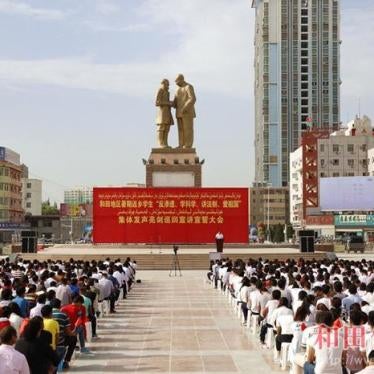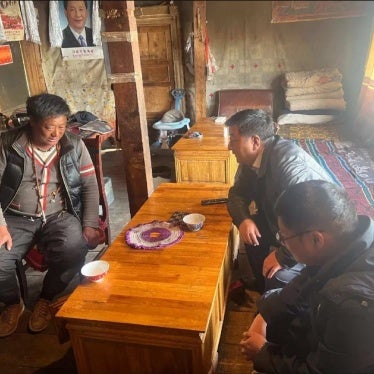(纽约)-人权观察今天表示,中国当局在新疆有系统地变更数百座村庄名称,将原本带有维吾尔族宗教、历史或文化意涵的名称换成反映中国共产党当前意识形态的名称。
人权观察研究发现,自2017年以来约有630个村庄被如此更名。最常用的前三个替换村名是“幸福”、“团结”与“和谐”。
“中国当局正在更改数以百计维吾尔村庄的名称,将原本对维吾尔人饶富意义的村名换成政府宣传词汇,” 人权观察中国部代理主任王松莲说。 “村名变更似乎是中国政府抹消维吾尔人文化与宗教表达的措施之一。”
在这项联合研究中,人权观察和设于挪威的维吾尔援助组织(Uyghur Hjelp)从中国国家统计局网站上抓取了2009年到2023年的新疆村庄名称。
全新疆25,000个村庄中,大约3,600个村庄在这段期间更名,其中五分之四看似正常调整,例如更改排序数字,或订正名称误植。但有630个即五分之一的村庄原本具宗教、文化或历史性质的名称遭到替换。
更名有三种类型。凡是提及宗教的村名一律遭到更换,包括伊斯兰词汇,例如苏菲派教士霍加(Hoja)和苏菲派建筑哈尼喀(haniqa)、也包括萨满教词汇,例如巫师巴合希。
凡是提及维吾尔历史的村名也被替换,包括曾由维吾尔人建立的王国、共和国领导人以及1949年中华人民共和国建立前的地方士绅姓名,乃至意为王宫的欧尔达(orda)、政治或荣誉官衔苏里坦(sultan)、博克(beg)。当局还换掉村名中象征维吾尔文化的字眼,例如麻扎(mazar),即圣徒墓地,以及都塔尔(dutar),即作为维吾尔音乐文化核心的两弦琴。
类似的更名措施似乎仍在持续进行,但大多发生在2017到2019年之间,即中国政府在新疆实施危害人类罪行的期间,而且大多发生在新疆南部喀什、阿克苏及和田等维吾尔居民占多数地区。
由于无法进入新疆地区,村名变更对居民生活的影响尚难充分查明。维吾尔援助组织访问到11名曾在被更名村庄居住维吾尔人,发现村名变更的经验对他们造成深刻冲击。一名从再教育营获释的村民在回家途中遇到困难,因为售票系统里面找不到原来的车站。后来她在申请各项政府服务的时候也因为村名变更而经常遇到麻烦。另一位村民说,他写了一首诗并请人谱成歌曲,纪念故乡周围所有消失的地名。
中国已签署但未批准的《公民权利和政治权利国际公约》第27条明定, “凡有种族、宗教或语言少数团体之国家,属于此类少数团体之人,与团体中其他分子共同享受其固有文化、信奉躬行其固有宗教或使用其固有语言之权利,不得剥夺之。”
联合国人权事务委员,即专责解释前述公约的独立专家机构,在其一般性意见中指出: “保护这些权利的目的是要确保有关少数群体的文化、宗教和社会特性得以存活和持续发展,从而丰富整个社会构造。⋯⋯这些权利本身必须受到保护”。
2014年5月,中国政府在新疆自治区发动“严厉打击暴力恐怖活动专项行动”。从2017年起,中国政府对新疆维吾尔族和其他突厥裔穆斯林实施广泛且有计划的攻击,包括大规模任意拘禁、酷刑、强迫失踪、大规模监控、文化和宗教迫害、拆散家庭、强迫劳动、性暴力以及违反生殖权利。人权观察于2021年认定前述各种侵犯行为构成危害人类罪。
中国政府向来将维吾尔人的日常宗教与文化活动,乃至他们对身分认同的表达,和暴力极端主义混为一谈,借此合理化对他们的侵犯行为。 2017年4月, 中国政府制定《新疆维吾尔自治区去极端化条例》,禁止“以非正常...起名渲染宗教狂热”。据报导,当局禁止了数十种世界各地穆斯林常用、带有宗教意涵的姓名,例如萨达姆(Saddam)、麦迪娜(Medina),理由就是这些名字可能“渲染宗教狂热”。
2022年8月,联合国人权事务高级专员办事处发表报告并于结论指出,中国政府在新疆的迫害行为 “可能构成国际犯罪,特别是危害人类罪。”人权观察表示,尽管许多国家对中国政府的新疆政策发出谴责,并有部分国家对涉及侵犯人权的中国政府官员、机构和企业实施针对制裁或其他制裁,这些应对措施仍与中国政府暴行的严重程度相去甚远。
“有关各国政府和联合国人权办事处应加大力度追究中国政府在维吾尔地区的侵害行为,” 维吾尔援助组织创办人阿卜杜韦力・阿尤普(Abduweli Ayub)说。“应当利用即将召开的联合国人权理事会会议和所有高级别双边会谈,施压中国政府释放因其严打行动而仍遭不法关押的数十万维吾尔人。”
有关村庄名称变更的更多详情,请参阅下文。
Examples of Village Name Changes
- In Kashgar Prefecture, Qutpidin Mazar village (库普丁麻扎村), named after a shrine of the 13th century Persian polymath and poet, Qutb al-Din al-Shirazi, was renamed Rose Flower village (玫瑰花村) in 2018;
- In Akto County, Kizilsu Kyrgyz Autonomous Prefecture, Aq Meschit (“white mosque”) village (阿克美其特村) was renamed Unity village (团结村) in 2018;
- In Aksu Prefecture, Hoja Eriq (“Sufi teacher’s creek”) village (霍加艾日克村), was renamed Willow village (柳树村) in 2018;
- In Karakax County, Dutar village (都塔尔村), named after a Uyghur musical instrument, was renamed Red Flag village (红旗村) in 2022.
A full list of these village names is available upon request.
Methodology
The National Bureau of Statistics of China publishes a list of “Administrative Division Codes for Statistics,” (统计用区划代码) in which each village is represented by a 12-digit code. These digits identify villages by the five administrative levels of China: province, city/prefecture, county, township, and village. In total, we were able to identify 25,394 unique Administrative Division Codes in the Xinjiang Uyghur Autonomous Region (XUAR) between 2009 and 2023 (the exact number fluctuates each year). Of these, 23,291 are villages.
To simplify the process of identifying those villages with changed names, we first removed the suffixes of the village names that simply denote “village,” given that they may appear in different variations, such as “农业村” (farming village) and “牧业村” (herding village).
We found 3,652 village names that had been changed between 2009 to 2023. About 1,254 of them involve name changes in Mandarin Chinese (the village names changed, but both the name before and the one after are in Mandarin Chinese). The bulk of Chinese-to-Chinese name changes involve mundane changes such as from “First Company” to “Third Company” of the Sixth Division of the Xinjiang Production and Construction Corps.
Since the Uyghur language does not have a standard transliteration scheme to Mandarin Chinese, many villages use different Chinese transliteration from year to year. Human Rights Watch used “edit distance” – an algorithm that computes the similarities between names before and after the change – and removed the ones that are different Chinese transliterations of the same Uyghur name.
The remaining name changes – about 1,000 – mostly involve changes from Uyghur to Chinese, though in some cases, both the before and after names are both in Uyghur, and a few changed from Mandarin Chinese to Uyghur. Among these 1,000, about 350 involve similarly benign changes, such as from Qumchi Östeng (“sandy canal”) village to Jigdelik (“a place with date trees”) village.
But about 630 of the name changes involve changes that remove a religious, historical, or Uyghur cultural term and replaces it with a name that is generic or one that fits the Chinese Communist Party’s ideology.
Analysis of Data
Certain words are more likely to be removed from a village name. In 2009, there were 47 villages in Xinjiang with the word “mazar” (shrine) in their names; all but 6 villages have removed the word from their names. “Hoja” (religious teacher) appeared in the names of 28 villages in 2016, but only 3 remained by 2023. Ten of thirteen villages in Xinjiang that had the word “haniqa” in them, which means a Sufi meeting house, had renamed them. There are now no more villages with the word “xelpe” or “khalifa” (ruler) in their names.
Table 1: Village name changes by specific word
Name | Meaning | Number of changes | Percentage of change |
麻扎/Mazar | Shrine/Tomb | -41 | -88% |
霍加/Hoja | A Sufi teacher | -25 | -89% |
美其特/Meschit | Mosque | -17 | -100% |
哈尼喀/Haniqa | Or khanqah in Persian or Arabic, which means “a Sufi meeting house” | -10 | -92% |
拱拜孜/Gombez | Dome | -9 | -92% |
欧尔达/Orda | Palace | -9 | -100% |
海利派/Xelpe | Or Khalifa in Arabic, which means “ruler” | -7 | -100% |
瓦普/Wap | Islamic Foundation | -6 | -78% |
阿吉/Hajj | Pilgrimage | -6 | -67% |
苏里坦/Sultan | Sultan | -6 | -100% |
“Happiness” (幸福), 69 more named “Unity” (团结), 55 more named “Harmony” (和谐), 38 more named “Bostan,” which is “oasis” in Uyghur, and 38 more named “Light” (光明). For example, in Aksu Prefecture, Xelpe Eriq village, which means “Ruler Creek” in Uyghur, was renamed “Unity New village” in 2017. Mazar Östeng village, which means “Shrine Canal village” in Uyghur in Hotan Prefecture, has been “Bright Light village” since 2020.
Table 2: Most common replacement terms in village names
Name | Meaning | Number of changes | Percentage of changes |
幸福 / Xingfu | Happiness | +79 | +75% |
团结 / Tuanjie | Unity | +69 | +55% |
和谐 /Hexie | Harmony | +55 | +98% |
博斯坦 / Bostan | Bostan/ Oasis | +38 | +37% |
光明 / Guangming | Light | +38 | +72% |
友谊 / Youyi | Friendship | +26 | +72% |
红旗 / Hongqi | Red Flag | +23 | +82% |
红星/ Hongxing | Red Star | +17 | +78% |
前进/Qianjin | Forward | +17 | +60% |








